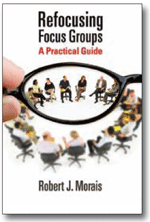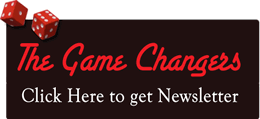Refreshing Focus Groups
By Robert J. Morais
Principal, Weinman Schnee Morais, Inc.
Even with so many market research options, from real-world based ethnographic observation to online panels to complex surveys, marketers still field hundreds of thousands of focus groups annually. Advocates see them as a fast, inexpensive way to hear consumers speak about what they need and want, as well as a means to personally witness consumers’ reactions to new product ideas, packaging innovations, and advertising concepts. At the same time, executives admit ruefully that they have allowed a few focus groups to determine a winning creative idea or predict the sales potential of a new product.
 I have witnessed thousands of focus groups and moderated many others. I am a champion of focus groups. At the same time, I am concerned about the selection of this research tool when another method would be superior. I worry when the wrong kinds of questions or too many questions, asked in machine gun fashion, mislead marketing and advertising agency executives. I fret that marketers, along with their advertising agency partners, make ill-informed judgments and arrive at non-projectable conclusions that can damage their business. Rather than allow my anxieties to lead me to end my association with focus groups, I decided to write Refocusing Focus Groups (Paramount Market Publishing 2010). The book lays out, in simple terms, the best practices for planning, designing, conducting, and interpreting focus groups. It draws upon perspectives and techniques from anthropology and psychology, along with decades of my own and other experts’ experience. Following are a few of the suggestions to be found in the book.
I have witnessed thousands of focus groups and moderated many others. I am a champion of focus groups. At the same time, I am concerned about the selection of this research tool when another method would be superior. I worry when the wrong kinds of questions or too many questions, asked in machine gun fashion, mislead marketing and advertising agency executives. I fret that marketers, along with their advertising agency partners, make ill-informed judgments and arrive at non-projectable conclusions that can damage their business. Rather than allow my anxieties to lead me to end my association with focus groups, I decided to write Refocusing Focus Groups (Paramount Market Publishing 2010). The book lays out, in simple terms, the best practices for planning, designing, conducting, and interpreting focus groups. It draws upon perspectives and techniques from anthropology and psychology, along with decades of my own and other experts’ experience. Following are a few of the suggestions to be found in the book.
The Value of Being Naïve
Anthropologists are experts at assuming a naïve stance because their job is to take nothing as a given. During qualitative research on a breakfast cereal, we asked respondents what breakfast is. We learned that breakfast is an in-between, ritual-like time when certain personal transformations occur. Early morning is a transitional period; consumers move over a threshold from sleep to waking, from their private to public self. The specific breakfast cereal brand they consume during this transition is an essential component of their transformational experience. In this research, we discovered that our brand’s sensate attributes of sweetness and crunch made respondents feel happy, optimistic, and even joyful, promising a positive beginning to their day. This is the stuff of great advertising.
A Cultural Perspective
In “Chief Culture Officer” (Basic Books 2009), anthropologist Grant McCracken argues that when corporations ignore culture, which he defines as “the body of ideas, emotions, and activities that make up the life of the consumer,” they place their organizations at risk in the marketplace. Cultural analysis can be applied in focus group settings, where connections between consumer buying behavior and culture can be made in much the same way that they can be discovered in ethnographic interviews. While the focus room setting precludes naturalistic observation, respondents can engage with stimuli such as supermarket style shelf sets, apparel, laptops, or any kind of material culture, and be questioned about how culturally driven behavior and beliefs relate to their consumption of goods and services.
Focus Group Interactions
One way to understand how consumers make purchase decisions is to watch them interact with those who influence these decisions. During interactional research in focus group rooms, it is possible to see and hear children ask their parents for their favorite brands and notice how their parents respond, observe the ways couples negotiate the purchase of big ticket items like cars, or watch the decision-making process used by friends as they discuss where to go for dinner.
My company conducted interactional research among doctors and patients when a client was marketing an innovative prescription contraceptive. We discovered that physicians assumed their patients were happier with their current contraceptive than they were in reality, so they did not encourage change or offer information about new methods unless asked. Only when the patients in the research mentioned reservations about their current method to the doctor or asked, “What’s new in contraception?” did the doctor discuss the new option. Based on this study, the client developed direct-to-consumer communications that sparked patients to inquire about new contraception solutions, as well as doctor-targeted messages to convince doctors that patients would react positively to the new method they were marketing.
Life Histories and Future Products
A psychologically oriented approach that my company calls Guided Retrospection can yield new product ideas. A manufacturer was exploring line extension possibilities for its carpet freshener. We asked respondents to reflect back on their lives and tell stories about their experiences with things or places that seem “fresh.” Among their comments were:
- Raking leaves at my grandparents’ house on an autumn day, the air clean and pure. I felt so alive. It was exhilarating.
- The smell of flowers at my communion. My grandmother gave us all flowers – carnations and daisies. I was overwhelmed by the fragrance of the flowers. I felt happy, proud, excited.
- My mom’s cooking: homemade pizza, making tomatoes into sauce. I felt content, relaxed.
- Sleeping on sheets my mom dried on the line. A smell, but not a smell…just clean.
Respondents were then asked to invent new products for the brand. Among their suggestions (paraphrased to protect confidentiality) were:
- Fresh Lift, a “rake” that lifts embedded dirt before vacuuming
- Old Carpet Freshener, which restores body and color vibrancy to aging carpets
- Fresh and Soft, which makes carpets smell great and feel softer
Not all of the new products flowed directly from the consumers’ reflections, but by taking respondents back to the sensation of fresh, we inspired them to create fresh ideas.
Conclusion
Focus Groups are the most used and abused qualitative marketing research technique. My hope is that Refocusing Focus Groups will help focus group practitioners improve the quality of this indispensable research methodology.
Bob Morais is a Principal in Weinman Schnee Morais, specializing is scientifically based, custom designed market research and marketing consulting. He can be reached at:


